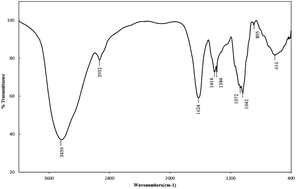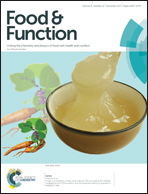A new heteropolysaccharide from the seed husks of Plantago asiatica L. with its thermal and antioxidant properties†
Abstract
A new heteropolysaccharide (PMH) with a molecular weight of 1.4 × 103 kDa was isolated from the seed husks of Plantago asiatica L. The monosaccharide composition of PMH was determined as glucose, xylose, arabinose, rhamnose, galactose and galacturonic acid with a molar ratio of 1.0 : 1.8 : 2.4 : 3.8 : 4.9 : 8.5. The backbone of PMH consisted of 1,4-β-D-GalpA with the side chains mainly composed of 1,3-α-D-Galp and 1,2-α-D-Galp which were attached to the O-3 of GlapA. The thermal analysis using the Flynn–Wall–Ozawa (FWO) method revealed that PMH had an apparent activation energy (Ea) of 173.1 kJ mol−1. PMH experienced a major decomposition during the heating process at a temperature of 91.1 °C with a dry weight loss of 31.1%. Moreover, PMH exhibited stronger antioxidant ability than commercial psyllium, partially due to its higher content of uronic acid. The results suggested that PMH could be used in functional foods due to its structural, thermal and antioxidant characteristics.



 Please wait while we load your content...
Please wait while we load your content...